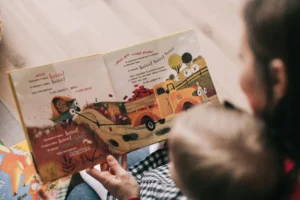Here’s the truth: most parents I work with begin the conversation with the same question, “How do you go about sleep training a baby without crying it out ?” The answer is simple: no matter what your parenting philosophy, your child’s sleep is what’s most important.
Congratulations! You’ve made it through the first few weeks (or months) with the newest member of your family without losing your mind…mostly!
You’re getting the hang of this whole parenting thing, and luckily this new kid sleeps – a lot. You’re pretty sure you landed the baby lottery with this one…
But just when you’re getting ready to tell all your friends about your “perfect little sleeper”, all of a sudden he or she stops being a perfect sleeper. Now they’re up all hours of the night, refusing to nap during the day, crying and screaming…and extremely unhappy.
A quick Google search for “how do I sleep train my baby” brings up a dreaded topic: leaving your baby to cry it out.
You’re not looking to put your child in any sort of distress – you’ve heard that letting your child cry it out is harmful, mean, and maybe even abusive!
But the fact is you need to sleep. And bad. You’re starting to feel like you can’t function as a human because you’re so sleep-deprived, and your family truly is suffering.
I hear you…because I was you.
And while most programs dealing with kids and sleep promise you a “tear-free” experience, in reality, you can’t expect a child who doesn’t have any language skills to never cry. (After all, that’s the only communication tool they have.)
There is hope, however, for anyone looking to teach their child good sleep habits…and it’s not as complicated as you may think.
Can You Sleep Train Without Crying?
I’ve gotten so many questions around the “cry it out (CIO)” method, it’s hard to put into words how triggering this topic is.
I work with parents every day who clearly love their children fiercely and want what’s best for them… which is why it’s so hard for us as parents to decide what to do for a child that will not sleep.
Modern-day experts have now labeled “crying it out” as extremely damaging to both parent and child, however, none of them seem to have a useful answer for what the alternative solution is.
So what’s a new parent to do? Can you sleep train without leaving your baby to cry it out? How do you sleep train a baby without crying it out?
Step One: Remember You’re In This Together
I always tell parents that teaching a child to sleep is like teaching any other skill. You would never drop them off at swimming lessons and say, see ya later! Good luck! You’re going to go in with them, to encourage them, comfort them and guide them along the way.
The same is true for teaching them to sleep. I encourage parents to be in the room for the entire process if they’d like to be. Comforting and teaching your little one, helping them build the necessary skills, and keeping the bond with your child in-tact is what’s most important – and something I take very seriously in my work.
Step Two: Get Educated on How Your Child Sleeps
Most sleep training “experts” will also advise you to start with a solid nap schedule, bedtime routine, and soothing technique. It’s great advice… if you already know how sleep actually happens.
It’s important to realize that you can start by doing any number of things, but if you don’t know the basics of how your baby sleeps and what they need to fall asleep, a brand new schedule or routine will do nothing for you!
Teaching your child good sleep habits starts with:
- Knowing the difference between newborn sleep and adult sleep.
- Getting educated on the four sleep stages, and the cycles we all go through during the night.
- Understanding the difference between a sleep prop (like pacifiers) and sleep aids (like sound machines).
- Becoming aware of your child’s specific rhythms, and creating a plan to match.
Only after we have a deep knowledge of how humans sleep can we begin to teach our children how to master it.
Step Three: Execute a Solid Sleep Plan
I would never advise you to go on your very first trip through a foreign country without a map. The same goes for when you’re trying to teach your child how to fall asleep on their own:
- You need to have a game plan for what you’ll do when baby still hasn’t fallen asleep and it’s 20 minutes past their nap time.
- You’ll need to know how to follow the game plan so you can help your child put themselves back to sleep (especially when they’re awake after just 30 minutes!)
- You’ll need to know how to tweak the game plan because “winging-it” just creates an even deeper cycle of bad sleep habits – which can lead to years of frustration and tears for both baby and you!
It’s so important to create a sleep plan for your child that you know will work. That way, when you run into bumps in the road, you’ll know exactly what to do and how to respond.
Baby Sleep Tips
“That’s great,” you might be thinking, “but where’s the real-life advice I so desperately need?”
There’s no need to wait until you’re pulling your hair out because of another unsuccessful naptime, and there’s no reason your child should ever have to “cry it out”. Here are my top five sleep tips for exhausted mamas (and babies):
Top Five Sleep Tips for Exhausted Mamas (And Babies)
- Make it dark in your child’s room. And I’m talking as dark as the coffee you’ve been drinking each morning to try and wake yourself up! Each time you put the baby down for a nap, make that room as dark as possible. (If you can’t see your hand in front of your face when you shut the door in their room, you’re doing it right.) Newborns and babies are extremely sensitive to light, so the darker you can get it, the longer they will sleep!
- Buy a sound machine. While some people will tell you that babies need absolute quiet to be able to sleep, research has shown that having a white noise machine can be extremely soothing for children and babies, and provides a good cue for when it’s time to sleep. My only recommendation for white noise machines is that you find one that cannot be turned up too loud – we want a soothing noise, like a fan. Not a jet engine that may be too loud for baby’s ears!
- Set a timer. Little ones have short windows for awake time. Even if relatives or friends want to see baby awake, set a timer and stick to your guns. Baby needs a nap! It’s even better if you can put your baby down for a nap before you think he or she will get tired. This will encourage them to fall asleep on their own, and will build those skills faster!
- Get into a rhythm. It may sound cliche, but getting more sleep around the clock really will help your child sleep better at night – and the next day, and the next! Get into a rhythm each day. Try and get those naps as tight as possible. Schedule bedtime at the exact same time every night. This may seem “too strict” but our little ones crave rhythms during the day, and the more sleep they get, the better they will sleep. (Research also shows that babies have their own sleep and awake rhythms from very early on…we’re talking within the womb!)
- Create good routines inside your overall sleep plan. You may already have a good bedtime routine, but have you set up a naptime routine as well? What’s your routine for when baby wakes up? While I don’t suggest you get super rigid with your child’s schedule each day, (after all, we’re busy parents! Who has time to start scheduling things down to the minute?) I do encourage our parents to have a natural order to things they do repeatedly throughout the day. Baby’s going down for nap number one? Let’s read a book, change their diaper, close the blinds, turn the sound machine on – in that order. And then repeat this process for every nap if you can help it. Baby will soon learn that they’re going through the same motions every time they’re getting ready for a nap, which will help ease them into sleep without a struggle.
A lot of babies I work with also absolutely love having these simple, yet powerful sleep mechanisms set up. Since we’re going for long-term, naturally easy sleep habits, the more we can teach our child at a young age the better.
Your Free Consultation With Rocky Mountain Sleeping Baby
And if you or your family are still struggling to figure out how to manage your child’s sleep, please don’t hesitate to book a 15-minute FREE consultation with a Rocky Mountain Sleeping Baby sleep coach! We’re not here to pressure you or sell you anything at all – we’re here to listen and come up with solutions so you can get back to the most important thing in your day – SLEEP!





